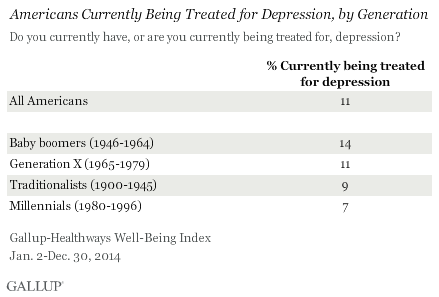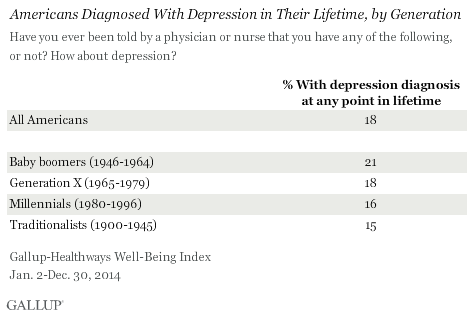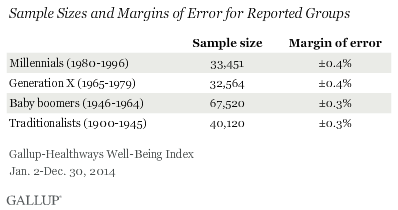Reports of Depression Treatment Highest Among Baby Boomers
STORY HIGHLIGHTS
- In U.S., one in seven boomers currently treated for depression
- One in five boomers (21%) diagnosed with depression in lifetime
WASHINGTON, D.C. — One in seven baby boomers (14%) say they are currently being treated for depression, which is a higher rate than among other generations of American adults. Boomers are followed by Generation Xers, at 11%, whose figure matches the national average.
Millennials (7%) are the least likely of the four generational groupings to say they are currently being treated for depression, followed by traditionalists (9%). The figures are based on more than 170,000 interviews Gallup conducted with U.S. adults about their mental health between Jan. 2 and Dec. 30, 2014 as part of the Gallup-Sharecare Well-Being Index.
Gallup and Sharecare have found in previous years that adults currently in their 50s and 60s — roughly spanning the baby boom generation — are among the age groups most susceptible to depression. The limited time span of Gallup’s depression data back to 2008 does not allow for an assessment of whether baby boomers have always had higher rates of depression, even at younger ages, or if boomers are currently at the age when depression is most likely to occur. Regardless of whether it is a generational or an age effect, as boomers reach retirement age, their higher reports of depression could have wider implications for their overall health and for the U.S. health system.
Traditionalists are less likely than baby boomers to report current depression, although this does not necessarily mean there will be a dip in depression rates among baby boomers as they age. The differences in the rate of depression diagnoses could reflect generational factors, such as the evolution of mental health sciences, which experienced profound revolutions in the mid-20th century. Many traditionalists were well into adulthood when President Harry Truman signed the 1946 National Mental Health Act, which spurred further research into treating mental illness, but most boomers were not yet born.
With the further research into mental illness, there have also been cultural shifts in the ways U.S. adults discussed depression. The timing of these cultural shifts could have created a rift between traditionalists, who over their lifetimes might have been less expressive about their mental health, and boomers who might have started to see it more acceptable for those feeling depressed to openly talk about it and to seek help.
Baby Boomers Most Likely to Have Been Diagnosed With Depression in Lifetime
Baby boomers (21%) also lead adults in any other age group in having been diagnosed with depression at any point in their lives.
Despite having lived the longest, as mentioned previously, members of traditionalist generation (15%) are the least likely to say they had ever been diagnosed with depression. In fact, the rate of depression diagnosis among traditionalists is roughly equal to that among millennials (16%).
Baby boomers could possibly be more prone to depression as a result of changes in the life situations and social pressures in which they find themselves, including financial pressures from impending retirement and paying for a child’s education. Midlife suicides have become more prominent as boomers reach middle age. Regardless, aging boomers’ higher rates of depression could put an unprecedented burden on mental health services if they maintain them.
Bottom Line
Current data on rates of depression among U.S. baby boomers when compared with other generations raise important questions about this generation’s rates of depression at younger ages.
If advancements in understanding of mental health are attributable to higher depression and treatment reports among baby boomers, this doesn’t answer why younger generations have lower reported rates of depression diagnosis. Perhaps Generation Xers and millennials have not yet reached the peak age of susceptibility to depression, or it is possible that they are less likely to be depressed.
SURVEY METHODS
Results are based on telephone interviews conducted Jan. 2-Dec. 30, 2014, as part of the Gallup-Sharecare Well-Being Index survey, with a random sample of 173,655 adults, aged 18 and older, living in all 50 U.S. states and the District of Columbia. For results based on the total sample of national adults, the margin of sampling error is ±0.2 percentage points at the 95% confidence level. All reported margins of sampling error include computed design effects for weighting.
Each sample of national adults includes a minimum quota of 50% cellphone respondents and 50% landline respondents, with additional minimum quotas by time zone within region. Landline and cellular telephone numbers are selected using random-digit-dial methods.
Learn more about how the Gallup-Sharecare Well-Being Index works.


